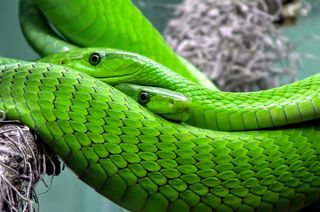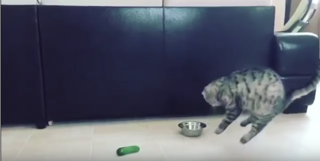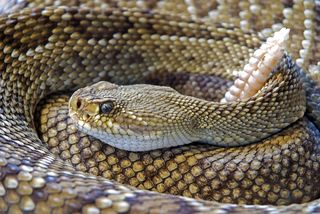
Fear
Scary Creatures: Why We Fear Snakes and Cats Fear Cucumbers
What ophidiophobia can teach us about designing for well-being.
Posted October 31, 2019

I’m not exactly sure how I happened to get sucked into the internet vortex of “cats versus cucumbers” YouTube videos. I’m not normally so susceptible to the charms of cat videos, but this overwhelming demonstration of a seemingly ingrained feline phobia of the docile cucumber is pretty fascinating.
We hear a lot these days about biophilia—which literally means “love of the living world”— and refers to the innate attraction humans have for the natural world. It explains why we love ocean views, spring flowers, and canopies of trees. We seem to be especially drawn to elements that signaled sources of nourishment or shelter to our prehistoric ancestors.
But it’s not just that we admire these natural forms and settings. They intimately impact our ability to think, heal, and create. Gazing at a tree can swiftly reduce blood pressure and the circulation of stress hormones (Ulrich, 2008). And over time, these effects are compounded. Patients healing from surgery in a room with a view of a tree can recover more quickly and experience less pain than those with a view of a brick wall (Ulrich, 1984).

But in all the rage for biophilia, we often forget to consider our biophobic, nature-fearing responses.
Much like cats’ cucumber phobia, many humans exhibit an extreme fear of snakes—known as ophidiophobia—not to mention spiders (arachnophobia). Why do our Halloween decorations include fake spiders, snakes, and rats along with goblins, ghouls, and ghosts?
Research from the University of Virginia has suggested that humans developed an innate ability to detect snakes and spiders, and an aptitude for quickly learning to fear them. Children as young as three were able to identify snakes hidden in camouflaged images more quickly than frogs, caterpillars, or flowers (Lobue & Delouche, 2008).

While snakes and spiders pose less of a threat to most modern humans than car accidents or gun crime, many of us continue to react with visceral fear at the site of them. Evolutionary psychologists believe this operates through a toolbox of “cognitive modules or programs” we have developed as a species. Each tool gives us a strategy that we have held onto because it helped us deal with a threat or problem that was key to our ancestors’ survival (Joye & van den Berg, 2011).
Snakes posed an ongoing threat due to their penchant for venomous biting and constricting. So even though many snakes are harmless, we tend to fall back on the general “snake-situation” tool in our toolbox, which directs us to scream eeek! and run away.
At least that was what I did when I almost stepped on a rattlesnake when I was eight. I believe we were told in school to back away slowly and quietly, but that’s not what my snake-situation instincts told me to do.

Personally, I'm also terrified of driving – an evolutionary adaptation better matched to the perils of modern life, perhaps? Then again, I have a lifetime record of two snake collisions (a garden snake once entangled itself in the wheels of my stroller) to zero car crashes. So I’m glad my snake-fear instincts have not been overwritten in relation to contemporary risk statistics.
The strength of these biophobic responses can help us understand the restorative power of biophilia. Our snake-alert system is triggered when we see non-threatening snakes, or even snake-like vines and garden hoses—much like cats with cucumbers. In the same way, our biophilic, greenery-loving response may be triggered by trees and flowers—or even pictures of them—that don’t specifically offer us apples or the ability to climb out of harm’s way.

So while we may like to decorate our homes with snakes and spiders during our annual Halloween celebration of scariness, we generally want to design spaces to reduce stress by echoing natural environments that would better support our survival — those linked with the goals of food, water, and shelter.
As for cats and cucumbers, the current evidence base, unfortunately, appears to be a bit spotty. Cat experts debate whether the cucumber phenomenon is based on a resemblance to snakes, or more of a reaction to the element of surprise—particularly when the innocent vegetable is placed behind the back of an unsuspecting cat trying to eat its dinner in peace.

Personally, I would hypothesize greater feline fear of surprising snake-like objects than say, the sheltering form of a cardboard box (which anecdotal evidence suggests cats are quite fond of). But until the scientific community finds time for a proper experiment, we’ll have entertained ourselves with cat videos.
This post is adapted from my book, The Shaping of Us: How Everyday Spaces Structure Our Lives, Behavior, and Well-Being, published by Trinity University Press in 2019.
References
Ulrich, R. (1984). View through a window may influence recovery from surgery. Science, 224 (4647), 420-421.
Ulrich, R. (2008). "Biophilic Theory and Research for Healthcare Design," in Kellert, S. R., Heerwagen, J. H., and Mador, M. L., Biophilic Design: The Theory, Science, and Practice of Bringing Buildings to Life, (pp. 87-104), Hoboken: Wiley.
Joye, Y., & van den Berg, A. (2011). Is Love for Green in Our Genes? A Critical Analysis of Evolutionary Assumptions in Restorative Environments Research. Urban Forestry & Urban Greening, 10 (4), 261-268.



